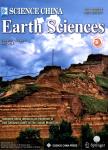Formation time of the big mantle wedge beneath eastern China and a new lithospheric thinning mechanism of the North China craton—Geodynamic effects of deep recycled carbon
Formation time of the big mantle wedge beneath eastern China and a new lithospheric thinning mechanism of the North China craton—Geodynamic effects of deep recycled carbon作者机构:State Key Laboratory of Geological Processes and Mineral Resources China University of Geosciences CAS Key Laboratory of Crust-Mantle Materials and Environments School of Earth and Space Sciences University of Science and Technology of China
出 版 物:《Science China Earth Sciences》 (中国科学(地球科学英文版))
年 卷 期:2018年第61卷第7期
页 面:853-868页
核心收录:
学科分类:070904[理学-构造地质学] 070801[理学-固体地球物理学] 0709[理学-地质学] 07[理学] 0708[理学-地球物理学] 0704[理学-天文学]
基 金:supported by the National Natural Science Foundation of China (Grant Nos. 41730214, 41473036, 91014007, 41230209) the Strategic Priority Research Program (B) of the Chinese Academy of Sciences (Grant No. XDB 18000000)
主 题:Big mantle wedge North China craton Lithospheric thinning Deep carbon recycling Alkaline basalts
摘 要:High-resolution P wave tomography shows that the subducting Pacific slab is stagnant in the mantle transition zone and forms a big mantle wedge beneath eastern China. The Mg isotopic investigation of large numbers of mantle-derived volcanic rocks from eastern China has revealed that carbonates carried by the subducted slab have been recycled into the upper mantle and formed carbonated peridotite overlying the mantle transition zone, which becomes the sources of various basalts. These basalts display light Mg isotopic compositions(δ26 Mg = –0.60‰ to –0.30‰) and relatively low87 Sr/86 Sr ratios(0.70314–0.70564) with ages ranging from 106 Ma to Quaternary, suggesting that their mantle source had been hybridized by recycled magnesite with minor dolomite and their initial melting occurred at 300-360 km in depth. Therefore, the carbonate metasomatism of their mantle source should have occurred at the depth larger than 360 km, which means that the subducted slab should be stagnant in the mantle transition zone forming the big mantle wedge before 106 Ma. This timing supports the rollback model of subducting slab to form the big mantle wedge. Based on high P-T experiment results, when carbonated silicate melts produced by partial melting of carbonated peridotite was raising and reached the bottom(180–120 km in depth) of cratonic lithosphere in North China, the carbonated silicate melts should have 25–18 wt% CO2 contents, with lower Si O2 and Al2 O3 contents, and higher Ca O/Al2 O3 values, similar to those of nephelinites and basanites, and have higher εNdvalues(2 to 6). The carbonatited silicate melts migrated upward and metasomatized the overlying lithospheric mantle, resulting in carbonated peridotite in the bottom of continental lithosphere beneath eastern China. As the craton lithospheric geotherm intersects the solidus of carbonated peridotite at 130 km in depth, the carbonated peridotite in the bottom of cratonic lithosphere should be partially melted, thus its physica



